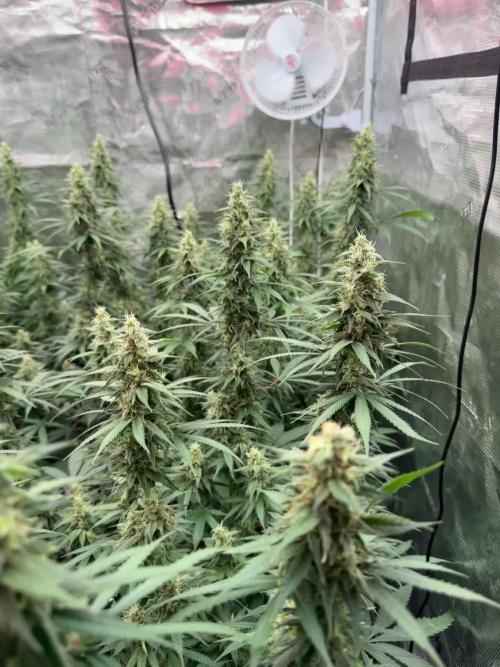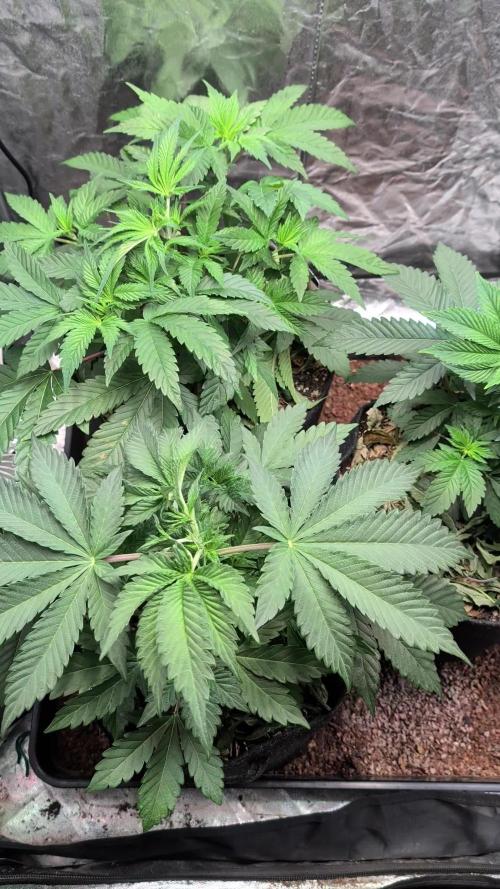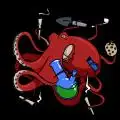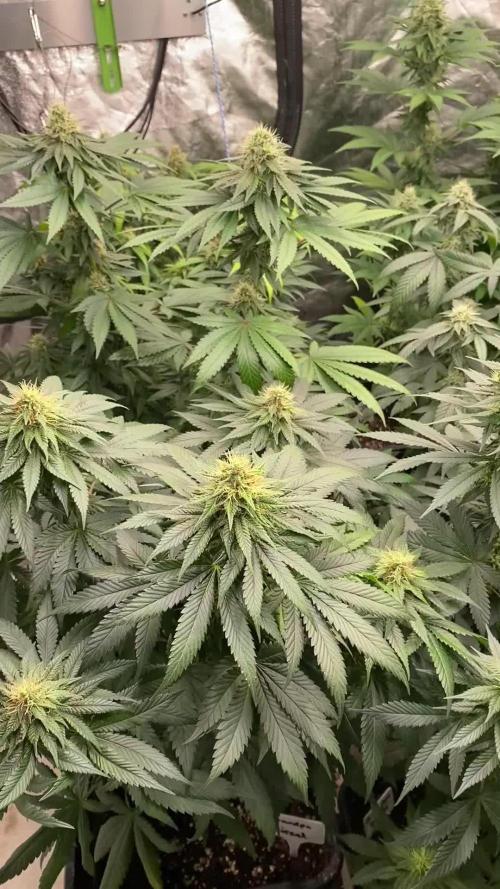The Grow Awards 2026 🏆 



























Likes
Comments
Share


@Hologram
Follow
Hi growmies,
this week the twins were not getting any sunlight at all so they had to keep each other warm in their clubhouse😸
now they are on my gardentable. to catch the few sunrays .. Peeking through the clouds..
One in 11 litr pot is 43cm
5L pot is 69 cm
5L- strechting like a beast..
she still looks like a big freak with her deformed leaves but i feel all she needs is just a few days of good sunlight (she is a bit 'droopy')
and she will make buds like a beast.. i feel it could go either way
or she will be a big bust
or shes gonna make the biggest buds ever!
11 l pot stands strong and trying to take care of the hedgehogs as good as possible
has bigger trunck and is much more sturdy..
she wil not dissapoint😎👌
They are getting a little bit attacked by spiders and spidermites in their clubhouse.. but thats no biggy
few snails too.. but they are big enough to not get bothered by them
and usually i catch them in their tracks (both, the spiders and the snails ;))
ihave only found one 'lil snail in my cheese..but have done no harm, just dazed from the cheese smell i think 😎👌
think gonna put some copper tape around the pot, just to be sure no snail invasion comes becouse it is so rainy..
but im just glad there are no caterpillers (yet) they can really munch on the plants!
see ya next week with another episode of the Cheese Twins Chronicles
hopefully in full sunlight!
happy growing for all✊
Likes
30
Share


@dataTwiiix
Follow
05_02: ça y est là flo. A démarrer.
Un grand merci à @xpertnutrients pour son support! Pour l'instant j'utilise que les booster et les micro nuts de la game et ça le fait 👌 nickel. Je suis impatient de faire un session avec uniquement du xpert nutrients. En tout Cas leurs additifs sont aux top!
Likes
15
Share


@FishTankGrow
Follow
Day 21 - Past week or so was rough (drooping leaves), which recovered during the night period. I figured it was either light or heat. Turns out the lights were way to bright (brown tips, bleaching leaves, drooping leaves). Turned off the 300 watt LED. Turned the Two 75 watt LEDS TO 40% plant is now stretching out nicely. Will turn light up slowly once stretch looks good. Happy New Year!
Day 22 - Stretch looks good turned lights up 5% and leaves stopped stretching so back to 40%.
Day 23 - Everything is resolved. Lights were way to bright. Caused the plant to stay short and brown tips. Reduced lights by 60% and now it’s beginning to stretch a little during the day and a lot at night. Added nutes back in and reduced the water to 2 cups per day.
Day 25 - added 5% on lights. Stretching nicely. Manage vertical growth with filling out using the lights.
Day 26 - looking good increased water to 12oz per day.
Day 27 - lights up 5% back down 5%. I leave it alone now. Couple gnats flying around. Not sure if it is a problem?
Likes
14
Share


@Gardens_of_Of
Follow
All the girls in the tent were cooked due to the high light intensity. So I had to dim the light down this week.
Under the hard conditions, they still grow beatiful flowers.
Likes
13
Share


@GrowGuy97
Follow
Flower day 31 - Having a little trouble with the temperature getting higher than I would like because my dehumidifier puts off some heat while it’s running so it’s been a constant struggle to keep the environment in this tent stable! Definitely will not have so many plants next run lol, but all in all the ladies are growing great & I can’t wait to see how they turn out! Thanks for following friends & happy growing!✌️🏼🌱
Flower day 33 - Fed half the plants today with PH at 6.4 to try and keep the humidity down some I’ll water the other half tomorrow!
Likes
80
Share


@Roberts
Follow
FBT2307 has sprouted. She had a membrane issue binding the leaves. I got the removed right before I updated. She is growing in the Athena blended line nutrition, under the Mars Hydro FC4800 light. Everything is look good now. Thank you Mars Hydro, and Fast Buds. 🤜🏻🤛🏻🌱🌱🌱
Thank you grow diaries community for the 👇likes👇, follows, comments, and subscriptions on my YouTube channel👇. ❄️🌱🍻
Happy Growing 🌱🌱🌱
https://youtube.com/channel/UCAhN7yRzWLpcaRHhMIQ7X4g
Likes
26
Share


@MiniBoxGrower
Follow
Like most beginners I am very impatient.
Therefore the following question can I be satisfied with growth so far ?
I haven't used any fertiliser so far because I put pre-fertilised soil in the pot when I repotted it.
It hasn't received much water yet either, I drowned a plant before, so I have become cautious.
I'm starting to think about training her, because I'm very limited in height.
5.5. 80ml
7.5. 100ml
11.5. 240m
Likes
32
Share


@Dunk_Junk
Follow
Wow she almost doubled her height this week!
She grew 29cm!!!!!
I think she's doing OK 💪
Likes
2
Share


@Valley
Follow
Geruch etwas weniger als erwartet trdm sehr sehr sehr geile terps bin gespannt wenn’s fertig gecured ist wie es dann schmeckt
Likes
5
Share


@ibbzy
Follow
Jesus! Smells like pineapples and some sort of exotic juice. Amazing. Definitely coming from the purple afghani lineage side
They’re chugging along nicely, will switch to the 10/14 next week and see if that helps with the ripening phase.
Sticky as hell, just brushing against them will feel like glue on your skin. Sticky, frosty and stinky!
Processing
Likes
26
Share


@eldruida_lamota
Follow
Buenos días familia, de vuelta actualizamos con la última semana en estado vegetativo, ya se cambió el fotoperiodo a 12/12
Y es que esta skunk están increíbles, tengo mucha curiosidad por ver que sale.
Ph controlado en 6.5 , el alimento lo aceptaron muy bien.
Temperatura algo baja por la noche, pero sin problema alguno, mínimas 17.
Se comportan genial en indoor y no espigan nada de nada, bastante recomendable.
Likes
6
Share


@Growtopus
Follow
Seofuku und Cookies and Cream wurden getoppt. Sie sind beide etwas größer als die Chemo Cake und so geben wir dieser etwas Zeit zum aufholen. Das starke Licht scheint etwas zu viel für sie zu sein.
Für alle drei gab es die zweite Dosis Pflanzengeflüster. 1,5 g in 100 ml auf drei Pflanzen verteilt.
Likes
12
Share


@PolezGardn
Follow
week two flower everything looks healthy :D
today i defoliated them
i watered them with 1.5l every 48h
the light i use was set to 80% and it hangs 80cm away from the tops
Likes
6
Share


@KingCatfish
Follow
Two autos are wierd ( small, over watered) plan on doing something to them but the rest is growing at good rates. Finishing up the flowering on a couple trees

































